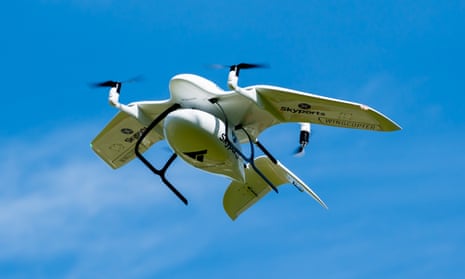A test project using powerful drones to fly urgent medical samples from isolated Scottish islands is being expanded this winter after successful recent trials.
The tests will involve flying blood and fluid samples from Hebridean islands such as Coll and Tiree to hospital labs on the mainland in a fraction of the time needed to take them by road and ferry.
After a week’s test run from a hospital in Oban to the island of Mull in the spring, the London-based firm Skyports and NHS Highland will test them during the winter to see how well they cope with much tougher flying conditions.
The longer trial, funded by the UK Space Agency, will allow NHS Highland to confirm whether drones can be permanently integrated into its transport of emergency supplies and test samples, and could eventually be used throughout Scotland’s islands.
The agency said its funding, which includes support for projects on mental health and loneliness using satellite technology, was intended to bolster the NHS’s capacity to cope with the coronavirus pandemic.

Alex Brown, the head of operations for Skyports, said drones had a huge advantage over conventional road and ferry routes. They are much faster and can travel much more directly between an island’s GP surgery and an NHS lab, he said, and more frequently than an NHS van dependent on ferry timetables and tide times.
That was extremely useful with time-sensitive or critical samples needed by pathology laboratories. “They know they’ve got logistics problems and they know pathology samples can take up to 48 hours to get to the lab,” he said.
“Transporting medical samples, you have to reduce the friction, whether that’s oceans, mountains or rivers, and you need an area where you can fly safely. That’s not the middle of London, but when you’re talking Orkney or Argyll and Bute, that ticks all the boxes,” he said.
The flights this spring over the 12 miles between the district hospital in Oban and Mull’s community hospital in Craignure took 15 minutes, far faster than the time taken by road and ferry.
The German-built drones carry loads of up to 6kg in a pod slung underneath the aircraft, which could be used to fly up to 50 miles in the next tests, which are due to take place from September.
Brown said the exact routes were still to be decided, but could include Coll and Tiree, and Campbeltown at the southern tip of the Mull of Kintyre. The trials would test how well the drones coped with winter weather.
“Looking at the weather data, we think we can fly 80% to 90% of the time, but there’s a difference between looking at numbers and being on site and doing it properly,” he said. He added that health officials in the Western Isles and Orkney were also interested.
Similar tests have been held in Belgium, involving the urgent transport of tissue samples from patients undergoing live operations to pathology laboratories.
A spokesman for Argyll and Bute health and social care partnership, which includes NHS Highland, said it was delighted to be involved. “The use of drones provides real opportunities to improve services and will help enable quicker diagnosis for our patients,” he said.
